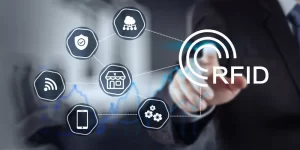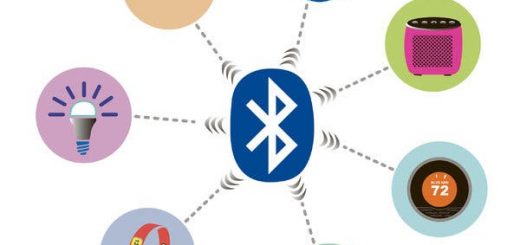RFID (radio frequency identification) review, features, types, use, advantages and disadvantages
RFID is an automatic ID system, such as a barcode or the magnetic strip on a credit card, the RFID tag offers a unique identification code that can be read by a scanning device, RFID uses radio waves to communicate with readers, When the reader picks up these waves, it converts them into digital data that identifies the object that contains the tag.
RFID (radio frequency identification)
RFID is an acronym for “radio-frequency identification”, It refers to a technology whereby digital data encoded in RFID tags or smart labels are captured by a reader via radio waves, RFID tag data can be read outside the line of sight, whereas barcodes must be aligned with an optical scanner.
RFID is a form of wireless communication, It incorporates the use of electromagnetic or electrostatic coupling in the radio frequency portion of the electromagnetic spectrum to uniquely identify an object, animal or person. Smart labels differ from RFID tags in that they incorporate both RFID and barcode technologies, They’re made of an adhesive label embedded with an RFID tag inlay, and they feature a barcode and/or other printed information.
Use of radio frequency identification
RFID technology is employed in many industries to perform tasks such as Inventory management, Asset tracking and equipment tracking, Personnel tracking, Controlling access to restricted areas, ID Badging, Supply chain management, and Counterfeit prevention (e.g. in the pharmaceutical industry).
RFID is used in pet and livestock tracking, cargo and supply chain logistics, vehicle tracking, customer service, and loss control, shipping, healthcare, manufacturing, retail sales, and tap-and-go credit card payments.
Types of RFID systems
Types of RFID systems are low frequency (LF), high frequency (HF), and ultra-high frequency (UHF), Microwave RFID is available, but frequencies vary greatly by country and region.
How does RFID work?
RFID system consists of a scanning antenna, a transceiver, and a transponder, When the scanning antenna and transceiver are combined, they are referred to as an RFID reader or interrogator, There are two types of RFID readers which are fixed readers and mobile readers, The RFID reader is the network-connected device that can be portable or permanently attached, It uses the radio waves to transmit signals that activate the tag, Once activated, the tag sends the wave back to the antenna, where it is translated into data.
RFID tags and smart labels
RFID tags are made up of the integrated circuit (IC), the antenna, and a substrate, The part of the RFID tag that encodes identifying information is called the RFID inlay. There are two main types of RFID tags: Passive RFID and Active RFID, An active RFID tag has its power source, often a battery, and the passive RFID tag receives its power from the reading antenna, whose electromagnetic wave induces a current in the RFID tag’s antenna.
Smart labels have an RFID tag embedded into an adhesive label and feature a barcode, They are used by both RFID and barcode readers, and they can be printed on-demand using desktop printers, where RFID tags require more advanced equipment.
RFID vs. NFC
Near-field communication (NFC) enables data to be exchanged between devices by using short-range, high-frequency wireless communication technology, NFC combines the interface of a smart card and reader into a single device.
RFID functions
Radio frequency identification (RFID) tagging system offers internal control of fixed assets, internal control of expensed assets, and theft prevention, The function of the RFID system is to make the physical inventory easier, An RFID tag should be physically attached to the asset at the time of acquisition and recorded in the property record, The tag number becomes the primary identifier for the asset because it is linked to all information in the record regarding that particular asset, Pre-numbered tags can also provide numerical control.
Advantages of RFID system
RFID takes up a fraction of a second to put an RFID key in the proximity to unlock the security system, The procedure is highly convenient and fast. The data on RFID systems are secure because it takes specialized equipment to read the data, This helps to maintain the lock system security.
RFID locks come with different ranges of cams and spindle lengths that can fit a wide range of doors and furniture, making them suitable for any business or application, Different kinds of locks can use one RFID key card to program, Which saves the users from the mess of having different cards for different locks while allowing each lock to have independent access policies.
The size of the card is handy and the same as a regular bank card, so, it is easy to store, Users have fewer chances of forgetting these cards when going to the place where they require access, and RFID cards are convenient and easy to store.
Disadvantages of RFID system
Set-Up of an RFID system is expensive and complex, It requires that locks are wired with a secured system that can be accessed, controlled, and logged through the computer system, You need to manually change your computer clock twice a year, This is required if the server computer is not connected to the internet or if there is a time-based access restriction.
Unlike traditional locks, forgetting or misplacing the modern keycard presents a double headache of figuring out how to open the lock or track back the keycard to access the appliances. RFID systems can be hacked by someone who is tech-savvy and offers a security issue. Electric RFID keycards malfunction when power outages, causing some lockers to shut you out or leave the lockers open, It offers a lot of uncertainty to the users of keycards.
The RFID system is prone to two main issues: Reader collision, when the signal from one RFID reader interferes with a second reader, can be prevented by using an anti-collision protocol to make RFID tags take turns transmitting to their appropriate reader. Tag collision occurs when too many tags confuse an RFID reader by transmitting data at the same time. Choosing a reader that gathers tag info one at a time will prevent this issue.
You can follow science online on YouTube from this link: Science online
You can download Science online application on Google Play from this link: Science online Apps on Google Play
NFC (Near Field Communication) uses, advantages and disadvantages
Digital Wallets uses, advantages and disadvantages
Mobile Wi-Fi Hotspot, Public Wi-Fi risks and disadvantages
Mobile Wi-Fi Hotspot features, types, uses, and advantages
What is a MiFi?, Portable Wi-Fi hotspot, Mi-Fi devices advantages & disadvantages
Wi-Fi health dangers and the radiation health effects of routers at home




